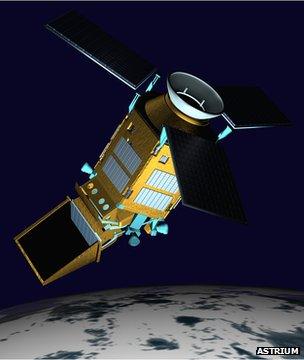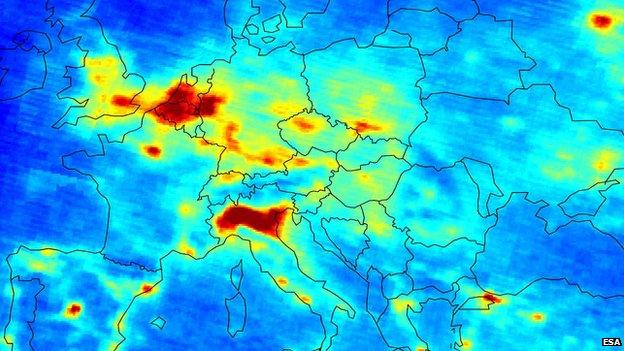UK to build atmospheric sentinel
- Published

Sentinel 5 Precursor is likely to be launched in 2015
British industry has been contracted to build a major European satellite to monitor atmospheric composition.
Known as Sentinel 5 Precursor (S5P), the spacecraft will track a range of chemical species, from protective gases such stratospheric ozone to damaging pollutants like sulphur dioxide.
S5P is part of a series of Earth observation satellites being launched by the European Union this decade.
The spacecraft is expected to go into orbit in early 2015.
"It's a compact satellite," said Andy Jones, the project manager at manufacturer Astrium.
"It's about one metre tall and 1.5m across. It's a hexagon shape with three solar arrays. S5P will be a seven-year mission but we will build the spacecraft to last for 10 years," he told BBC News.
The European Union's technical agent on the project is the European Space Agency (Esa), and it was with Esa that Astrium signed the 45.5m euro (£40m) contract in London on Wednesday evening.
It makes S5P the first Esa-commissioned satellite to be primed out of the UK for seven years.
The spacecraft will be put together in the company's Stevenage cleanroom. It will incorporate components from across Europe, including the all-important Tropospheric Monitoring Instrument (Tropomi).
This is a next-generation imaging absorption spectrometer, which will detect the presence of different trace gases and aerosols in the atmosphere. These are substances like the nitrogen oxides (NOx) produced by vehicles and which can lead to the production of smog and acid rain.
Tropomi is being constructed by a Dutch consortium, led scientifically by the KNMI (Royal Netherlands Meteorological Institute).

Tropomi will continue measurements of pollutants such as nitrogen oxides, which are produced by power plants, heavy industry and road transport
The word "Precursor" appears in the name of the new satellite because Tropomi is eventually destined to fly on Europe's future polar orbiting weather spacecraft. But the first of these will not be ready until 2020 and the satellites (Esa's Envisat and Nasa's Aura) that currently provide this trace gas and aerosol data will very shortly be retired.
"Envisat will retire in 2013, maybe 2014, but certainly no later," explained Volker Liebig, Esa's director of Earth observation. "Sentinel 5 Precursor must therefore fill the gap until 2020."
Other Sentinels have been ordered by the EU as part of its Global Monitoring for Environment and Security (GMES) programme.
This ambitious Earth observation project will gather key data to inform climate studies, but also to help enforce European laws.
It is, however, a programme struggling to find a settled budget currently.
The European Commission wants to fund GMES' expected 5.8bn-euro (£5bn) cost between 2014 and 2020 from outside the main EU budget, something which is opposed by many member states who say it must be included inside the so-called multi-annual financial framework.
Esa needs the matter to be resolved soon so that it can get on with the roll-out of the Sentinels.
"We are in very good shape but we need to make a decision next year on the launch of the first Sentinel," said Dr Liebig.
"This is a problem for us if we do not have an operational budget assured. We could find ourselves in a situation where the satellites are ready on the ground but with no operational budget to put them in space."
Britain secured the S5P work for its national industry by promising in 2008 to invest 102m euros (£87m) in the research and development aspects of GMES co-ordinated by Esa.